Evidence-Based Nursing Research on Preventing Cardiovascular Disease in Children
VerifiedAdded on 2023/06/10
|10
|2906
|441
AI Summary
This paper focuses on the importance of nursing research in evidence-based practice and undertakes a systematic review of primary research to find out whether informative programs on lifestyle alterations compared to community recreation exercises diminish the risk of later cardiovascular disease development in the paediatric population. The literature review highlights the effectiveness of lifestyle interventions in reducing obesity and overweight, which ultimately reduces cardiovascular disease. The paper recommends more research to pinpoint which intervention is better in reducing children’s risk of developing cardiovascular disease.
Contribute Materials
Your contribution can guide someone’s learning journey. Share your
documents today.
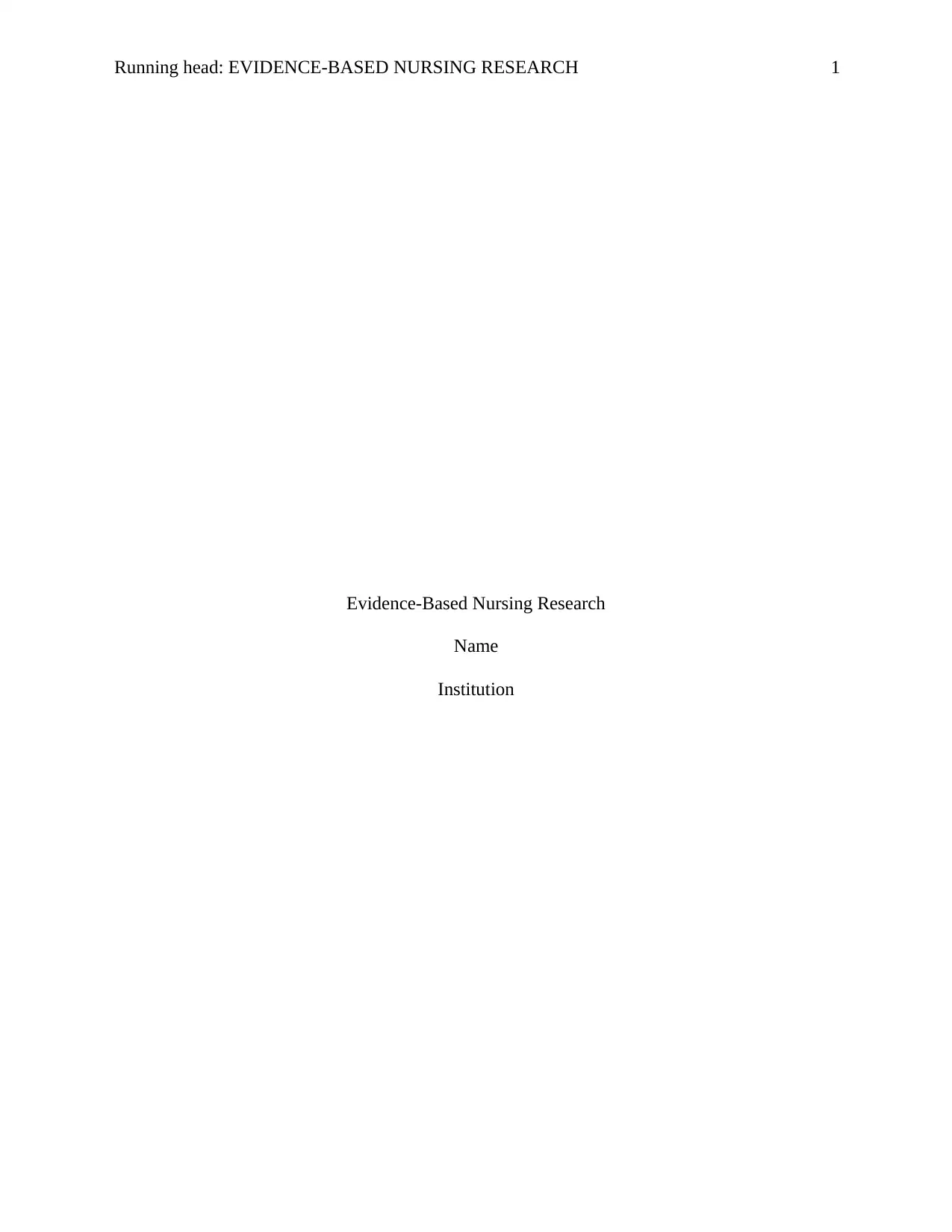
Running head: EVIDENCE-BASED NURSING RESEARCH 1
Evidence-Based Nursing Research
Name
Institution
Evidence-Based Nursing Research
Name
Institution
Secure Best Marks with AI Grader
Need help grading? Try our AI Grader for instant feedback on your assignments.
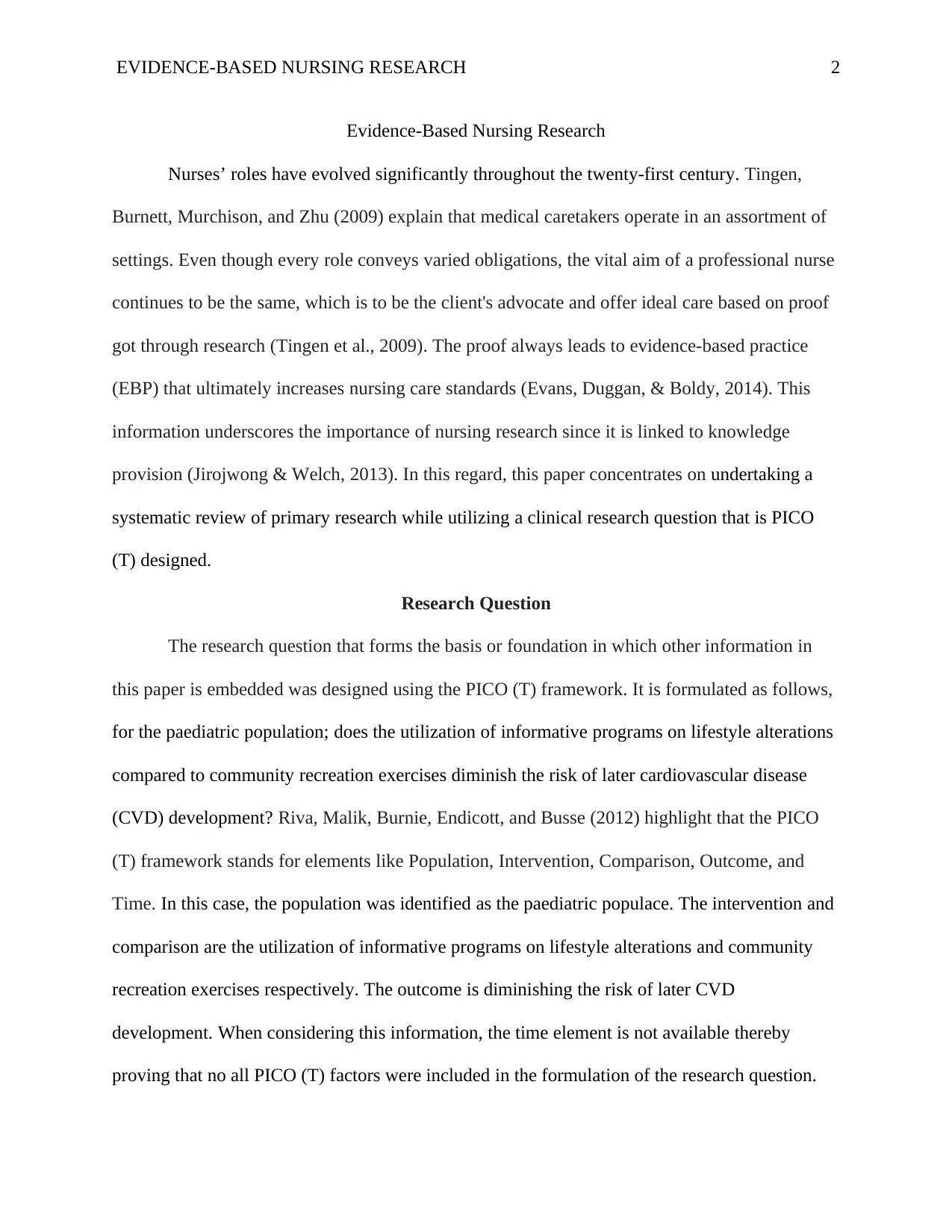
EVIDENCE-BASED NURSING RESEARCH 2
Evidence-Based Nursing Research
Nurses’ roles have evolved significantly throughout the twenty-first century. Tingen,
Burnett, Murchison, and Zhu (2009) explain that medical caretakers operate in an assortment of
settings. Even though every role conveys varied obligations, the vital aim of a professional nurse
continues to be the same, which is to be the client's advocate and offer ideal care based on proof
got through research (Tingen et al., 2009). The proof always leads to evidence-based practice
(EBP) that ultimately increases nursing care standards (Evans, Duggan, & Boldy, 2014). This
information underscores the importance of nursing research since it is linked to knowledge
provision (Jirojwong & Welch, 2013). In this regard, this paper concentrates on undertaking a
systematic review of primary research while utilizing a clinical research question that is PICO
(T) designed.
Research Question
The research question that forms the basis or foundation in which other information in
this paper is embedded was designed using the PICO (T) framework. It is formulated as follows,
for the paediatric population; does the utilization of informative programs on lifestyle alterations
compared to community recreation exercises diminish the risk of later cardiovascular disease
(CVD) development? Riva, Malik, Burnie, Endicott, and Busse (2012) highlight that the PICO
(T) framework stands for elements like Population, Intervention, Comparison, Outcome, and
Time. In this case, the population was identified as the paediatric populace. The intervention and
comparison are the utilization of informative programs on lifestyle alterations and community
recreation exercises respectively. The outcome is diminishing the risk of later CVD
development. When considering this information, the time element is not available thereby
proving that no all PICO (T) factors were included in the formulation of the research question.
Evidence-Based Nursing Research
Nurses’ roles have evolved significantly throughout the twenty-first century. Tingen,
Burnett, Murchison, and Zhu (2009) explain that medical caretakers operate in an assortment of
settings. Even though every role conveys varied obligations, the vital aim of a professional nurse
continues to be the same, which is to be the client's advocate and offer ideal care based on proof
got through research (Tingen et al., 2009). The proof always leads to evidence-based practice
(EBP) that ultimately increases nursing care standards (Evans, Duggan, & Boldy, 2014). This
information underscores the importance of nursing research since it is linked to knowledge
provision (Jirojwong & Welch, 2013). In this regard, this paper concentrates on undertaking a
systematic review of primary research while utilizing a clinical research question that is PICO
(T) designed.
Research Question
The research question that forms the basis or foundation in which other information in
this paper is embedded was designed using the PICO (T) framework. It is formulated as follows,
for the paediatric population; does the utilization of informative programs on lifestyle alterations
compared to community recreation exercises diminish the risk of later cardiovascular disease
(CVD) development? Riva, Malik, Burnie, Endicott, and Busse (2012) highlight that the PICO
(T) framework stands for elements like Population, Intervention, Comparison, Outcome, and
Time. In this case, the population was identified as the paediatric populace. The intervention and
comparison are the utilization of informative programs on lifestyle alterations and community
recreation exercises respectively. The outcome is diminishing the risk of later CVD
development. When considering this information, the time element is not available thereby
proving that no all PICO (T) factors were included in the formulation of the research question.
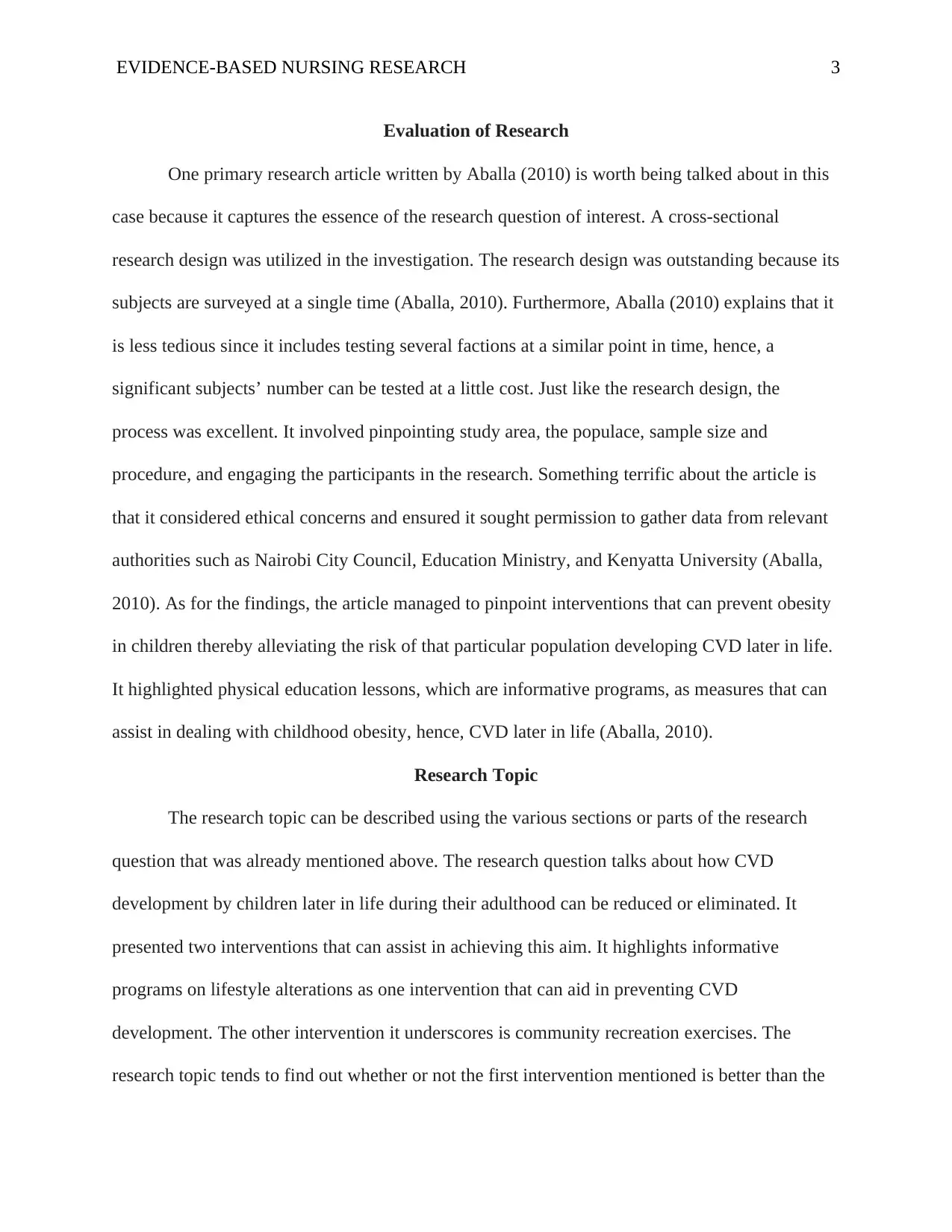
EVIDENCE-BASED NURSING RESEARCH 3
Evaluation of Research
One primary research article written by Aballa (2010) is worth being talked about in this
case because it captures the essence of the research question of interest. A cross-sectional
research design was utilized in the investigation. The research design was outstanding because its
subjects are surveyed at a single time (Aballa, 2010). Furthermore, Aballa (2010) explains that it
is less tedious since it includes testing several factions at a similar point in time, hence, a
significant subjects’ number can be tested at a little cost. Just like the research design, the
process was excellent. It involved pinpointing study area, the populace, sample size and
procedure, and engaging the participants in the research. Something terrific about the article is
that it considered ethical concerns and ensured it sought permission to gather data from relevant
authorities such as Nairobi City Council, Education Ministry, and Kenyatta University (Aballa,
2010). As for the findings, the article managed to pinpoint interventions that can prevent obesity
in children thereby alleviating the risk of that particular population developing CVD later in life.
It highlighted physical education lessons, which are informative programs, as measures that can
assist in dealing with childhood obesity, hence, CVD later in life (Aballa, 2010).
Research Topic
The research topic can be described using the various sections or parts of the research
question that was already mentioned above. The research question talks about how CVD
development by children later in life during their adulthood can be reduced or eliminated. It
presented two interventions that can assist in achieving this aim. It highlights informative
programs on lifestyle alterations as one intervention that can aid in preventing CVD
development. The other intervention it underscores is community recreation exercises. The
research topic tends to find out whether or not the first intervention mentioned is better than the
Evaluation of Research
One primary research article written by Aballa (2010) is worth being talked about in this
case because it captures the essence of the research question of interest. A cross-sectional
research design was utilized in the investigation. The research design was outstanding because its
subjects are surveyed at a single time (Aballa, 2010). Furthermore, Aballa (2010) explains that it
is less tedious since it includes testing several factions at a similar point in time, hence, a
significant subjects’ number can be tested at a little cost. Just like the research design, the
process was excellent. It involved pinpointing study area, the populace, sample size and
procedure, and engaging the participants in the research. Something terrific about the article is
that it considered ethical concerns and ensured it sought permission to gather data from relevant
authorities such as Nairobi City Council, Education Ministry, and Kenyatta University (Aballa,
2010). As for the findings, the article managed to pinpoint interventions that can prevent obesity
in children thereby alleviating the risk of that particular population developing CVD later in life.
It highlighted physical education lessons, which are informative programs, as measures that can
assist in dealing with childhood obesity, hence, CVD later in life (Aballa, 2010).
Research Topic
The research topic can be described using the various sections or parts of the research
question that was already mentioned above. The research question talks about how CVD
development by children later in life during their adulthood can be reduced or eliminated. It
presented two interventions that can assist in achieving this aim. It highlights informative
programs on lifestyle alterations as one intervention that can aid in preventing CVD
development. The other intervention it underscores is community recreation exercises. The
research topic tends to find out whether or not the first intervention mentioned is better than the
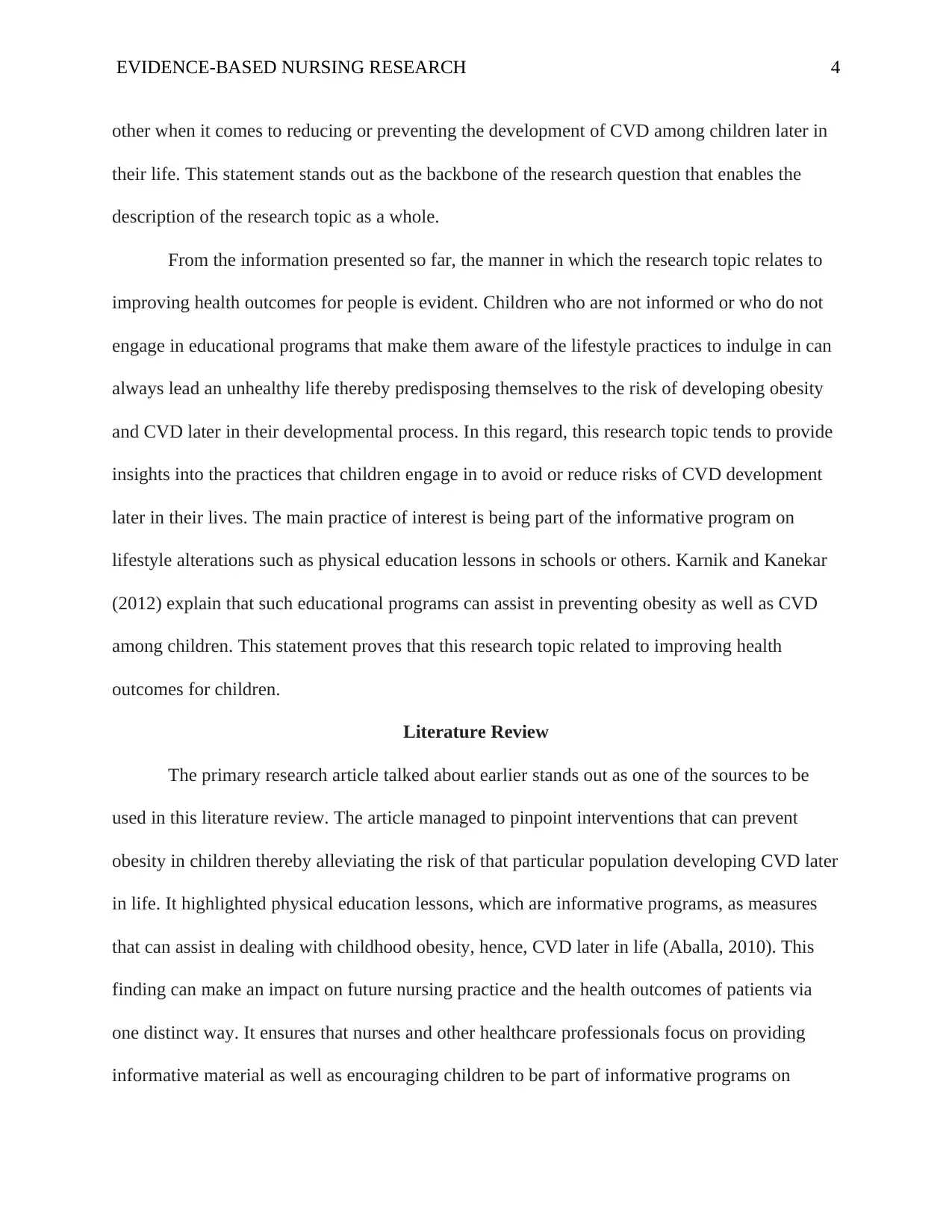
EVIDENCE-BASED NURSING RESEARCH 4
other when it comes to reducing or preventing the development of CVD among children later in
their life. This statement stands out as the backbone of the research question that enables the
description of the research topic as a whole.
From the information presented so far, the manner in which the research topic relates to
improving health outcomes for people is evident. Children who are not informed or who do not
engage in educational programs that make them aware of the lifestyle practices to indulge in can
always lead an unhealthy life thereby predisposing themselves to the risk of developing obesity
and CVD later in their developmental process. In this regard, this research topic tends to provide
insights into the practices that children engage in to avoid or reduce risks of CVD development
later in their lives. The main practice of interest is being part of the informative program on
lifestyle alterations such as physical education lessons in schools or others. Karnik and Kanekar
(2012) explain that such educational programs can assist in preventing obesity as well as CVD
among children. This statement proves that this research topic related to improving health
outcomes for children.
Literature Review
The primary research article talked about earlier stands out as one of the sources to be
used in this literature review. The article managed to pinpoint interventions that can prevent
obesity in children thereby alleviating the risk of that particular population developing CVD later
in life. It highlighted physical education lessons, which are informative programs, as measures
that can assist in dealing with childhood obesity, hence, CVD later in life (Aballa, 2010). This
finding can make an impact on future nursing practice and the health outcomes of patients via
one distinct way. It ensures that nurses and other healthcare professionals focus on providing
informative material as well as encouraging children to be part of informative programs on
other when it comes to reducing or preventing the development of CVD among children later in
their life. This statement stands out as the backbone of the research question that enables the
description of the research topic as a whole.
From the information presented so far, the manner in which the research topic relates to
improving health outcomes for people is evident. Children who are not informed or who do not
engage in educational programs that make them aware of the lifestyle practices to indulge in can
always lead an unhealthy life thereby predisposing themselves to the risk of developing obesity
and CVD later in their developmental process. In this regard, this research topic tends to provide
insights into the practices that children engage in to avoid or reduce risks of CVD development
later in their lives. The main practice of interest is being part of the informative program on
lifestyle alterations such as physical education lessons in schools or others. Karnik and Kanekar
(2012) explain that such educational programs can assist in preventing obesity as well as CVD
among children. This statement proves that this research topic related to improving health
outcomes for children.
Literature Review
The primary research article talked about earlier stands out as one of the sources to be
used in this literature review. The article managed to pinpoint interventions that can prevent
obesity in children thereby alleviating the risk of that particular population developing CVD later
in life. It highlighted physical education lessons, which are informative programs, as measures
that can assist in dealing with childhood obesity, hence, CVD later in life (Aballa, 2010). This
finding can make an impact on future nursing practice and the health outcomes of patients via
one distinct way. It ensures that nurses and other healthcare professionals focus on providing
informative material as well as encouraging children to be part of informative programs on
Secure Best Marks with AI Grader
Need help grading? Try our AI Grader for instant feedback on your assignments.
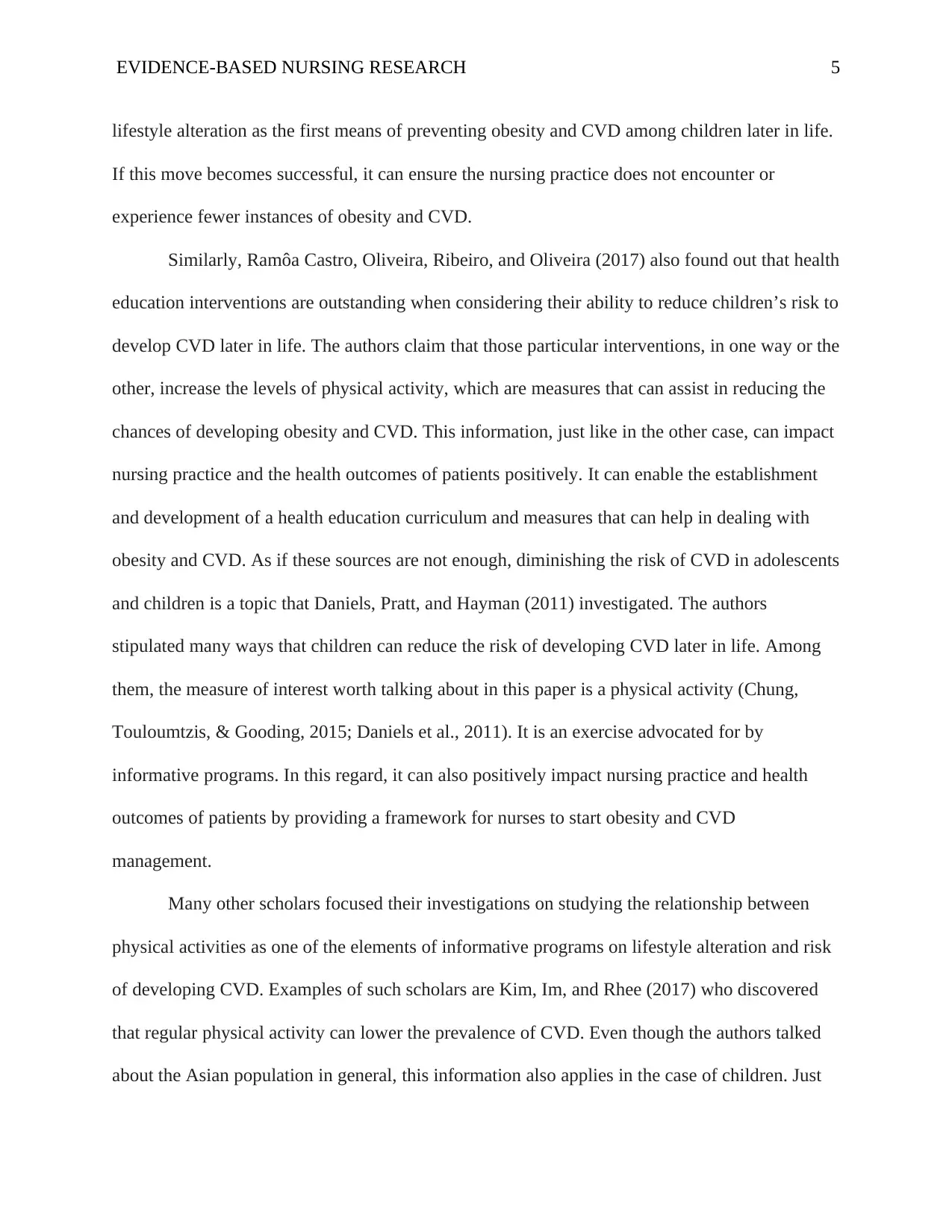
EVIDENCE-BASED NURSING RESEARCH 5
lifestyle alteration as the first means of preventing obesity and CVD among children later in life.
If this move becomes successful, it can ensure the nursing practice does not encounter or
experience fewer instances of obesity and CVD.
Similarly, Ramôa Castro, Oliveira, Ribeiro, and Oliveira (2017) also found out that health
education interventions are outstanding when considering their ability to reduce children’s risk to
develop CVD later in life. The authors claim that those particular interventions, in one way or the
other, increase the levels of physical activity, which are measures that can assist in reducing the
chances of developing obesity and CVD. This information, just like in the other case, can impact
nursing practice and the health outcomes of patients positively. It can enable the establishment
and development of a health education curriculum and measures that can help in dealing with
obesity and CVD. As if these sources are not enough, diminishing the risk of CVD in adolescents
and children is a topic that Daniels, Pratt, and Hayman (2011) investigated. The authors
stipulated many ways that children can reduce the risk of developing CVD later in life. Among
them, the measure of interest worth talking about in this paper is a physical activity (Chung,
Touloumtzis, & Gooding, 2015; Daniels et al., 2011). It is an exercise advocated for by
informative programs. In this regard, it can also positively impact nursing practice and health
outcomes of patients by providing a framework for nurses to start obesity and CVD
management.
Many other scholars focused their investigations on studying the relationship between
physical activities as one of the elements of informative programs on lifestyle alteration and risk
of developing CVD. Examples of such scholars are Kim, Im, and Rhee (2017) who discovered
that regular physical activity can lower the prevalence of CVD. Even though the authors talked
about the Asian population in general, this information also applies in the case of children. Just
lifestyle alteration as the first means of preventing obesity and CVD among children later in life.
If this move becomes successful, it can ensure the nursing practice does not encounter or
experience fewer instances of obesity and CVD.
Similarly, Ramôa Castro, Oliveira, Ribeiro, and Oliveira (2017) also found out that health
education interventions are outstanding when considering their ability to reduce children’s risk to
develop CVD later in life. The authors claim that those particular interventions, in one way or the
other, increase the levels of physical activity, which are measures that can assist in reducing the
chances of developing obesity and CVD. This information, just like in the other case, can impact
nursing practice and the health outcomes of patients positively. It can enable the establishment
and development of a health education curriculum and measures that can help in dealing with
obesity and CVD. As if these sources are not enough, diminishing the risk of CVD in adolescents
and children is a topic that Daniels, Pratt, and Hayman (2011) investigated. The authors
stipulated many ways that children can reduce the risk of developing CVD later in life. Among
them, the measure of interest worth talking about in this paper is a physical activity (Chung,
Touloumtzis, & Gooding, 2015; Daniels et al., 2011). It is an exercise advocated for by
informative programs. In this regard, it can also positively impact nursing practice and health
outcomes of patients by providing a framework for nurses to start obesity and CVD
management.
Many other scholars focused their investigations on studying the relationship between
physical activities as one of the elements of informative programs on lifestyle alteration and risk
of developing CVD. Examples of such scholars are Kim, Im, and Rhee (2017) who discovered
that regular physical activity can lower the prevalence of CVD. Even though the authors talked
about the Asian population in general, this information also applies in the case of children. Just
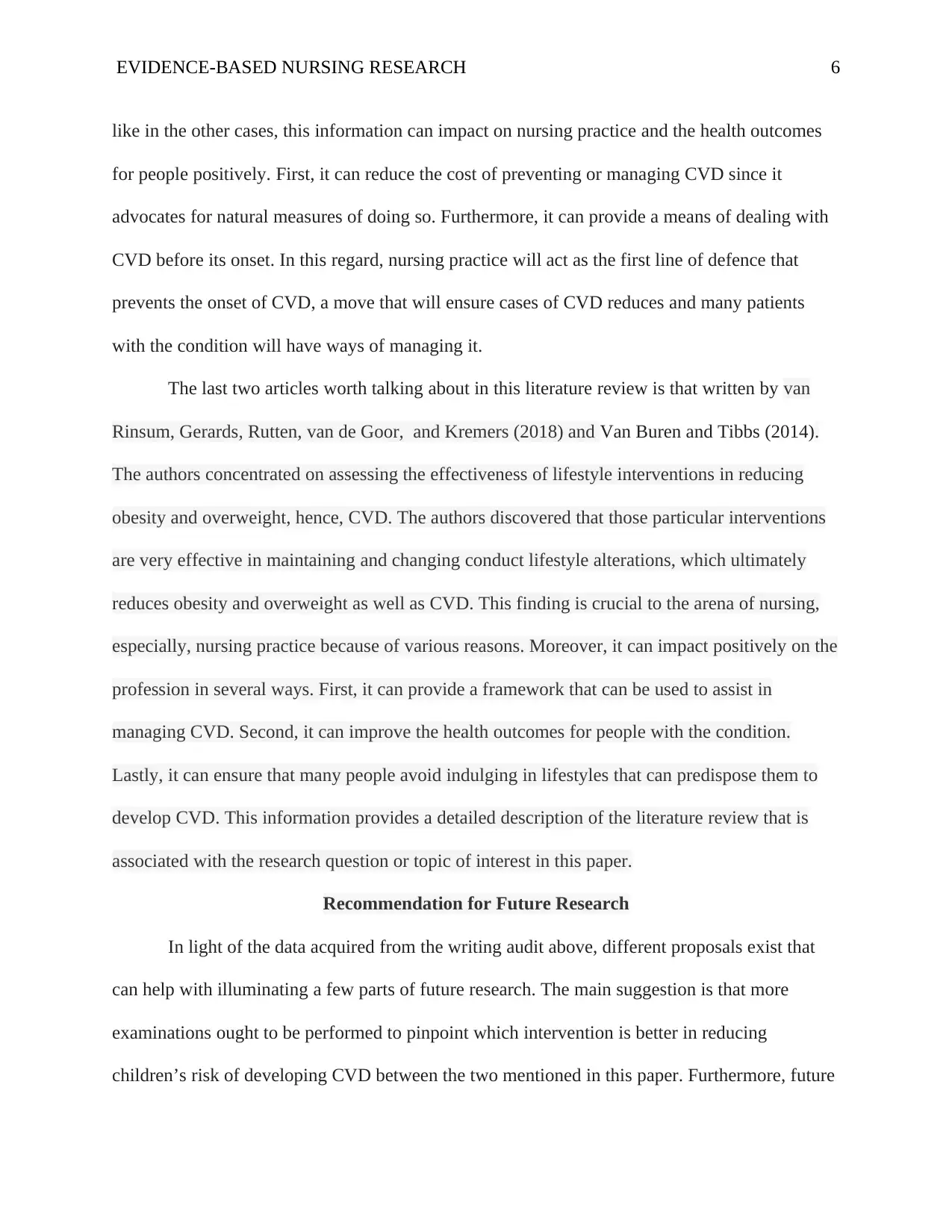
EVIDENCE-BASED NURSING RESEARCH 6
like in the other cases, this information can impact on nursing practice and the health outcomes
for people positively. First, it can reduce the cost of preventing or managing CVD since it
advocates for natural measures of doing so. Furthermore, it can provide a means of dealing with
CVD before its onset. In this regard, nursing practice will act as the first line of defence that
prevents the onset of CVD, a move that will ensure cases of CVD reduces and many patients
with the condition will have ways of managing it.
The last two articles worth talking about in this literature review is that written by van
Rinsum, Gerards, Rutten, van de Goor, and Kremers (2018) and Van Buren and Tibbs (2014).
The authors concentrated on assessing the effectiveness of lifestyle interventions in reducing
obesity and overweight, hence, CVD. The authors discovered that those particular interventions
are very effective in maintaining and changing conduct lifestyle alterations, which ultimately
reduces obesity and overweight as well as CVD. This finding is crucial to the arena of nursing,
especially, nursing practice because of various reasons. Moreover, it can impact positively on the
profession in several ways. First, it can provide a framework that can be used to assist in
managing CVD. Second, it can improve the health outcomes for people with the condition.
Lastly, it can ensure that many people avoid indulging in lifestyles that can predispose them to
develop CVD. This information provides a detailed description of the literature review that is
associated with the research question or topic of interest in this paper.
Recommendation for Future Research
In light of the data acquired from the writing audit above, different proposals exist that
can help with illuminating a few parts of future research. The main suggestion is that more
examinations ought to be performed to pinpoint which intervention is better in reducing
children’s risk of developing CVD between the two mentioned in this paper. Furthermore, future
like in the other cases, this information can impact on nursing practice and the health outcomes
for people positively. First, it can reduce the cost of preventing or managing CVD since it
advocates for natural measures of doing so. Furthermore, it can provide a means of dealing with
CVD before its onset. In this regard, nursing practice will act as the first line of defence that
prevents the onset of CVD, a move that will ensure cases of CVD reduces and many patients
with the condition will have ways of managing it.
The last two articles worth talking about in this literature review is that written by van
Rinsum, Gerards, Rutten, van de Goor, and Kremers (2018) and Van Buren and Tibbs (2014).
The authors concentrated on assessing the effectiveness of lifestyle interventions in reducing
obesity and overweight, hence, CVD. The authors discovered that those particular interventions
are very effective in maintaining and changing conduct lifestyle alterations, which ultimately
reduces obesity and overweight as well as CVD. This finding is crucial to the arena of nursing,
especially, nursing practice because of various reasons. Moreover, it can impact positively on the
profession in several ways. First, it can provide a framework that can be used to assist in
managing CVD. Second, it can improve the health outcomes for people with the condition.
Lastly, it can ensure that many people avoid indulging in lifestyles that can predispose them to
develop CVD. This information provides a detailed description of the literature review that is
associated with the research question or topic of interest in this paper.
Recommendation for Future Research
In light of the data acquired from the writing audit above, different proposals exist that
can help with illuminating a few parts of future research. The main suggestion is that more
examinations ought to be performed to pinpoint which intervention is better in reducing
children’s risk of developing CVD between the two mentioned in this paper. Furthermore, future
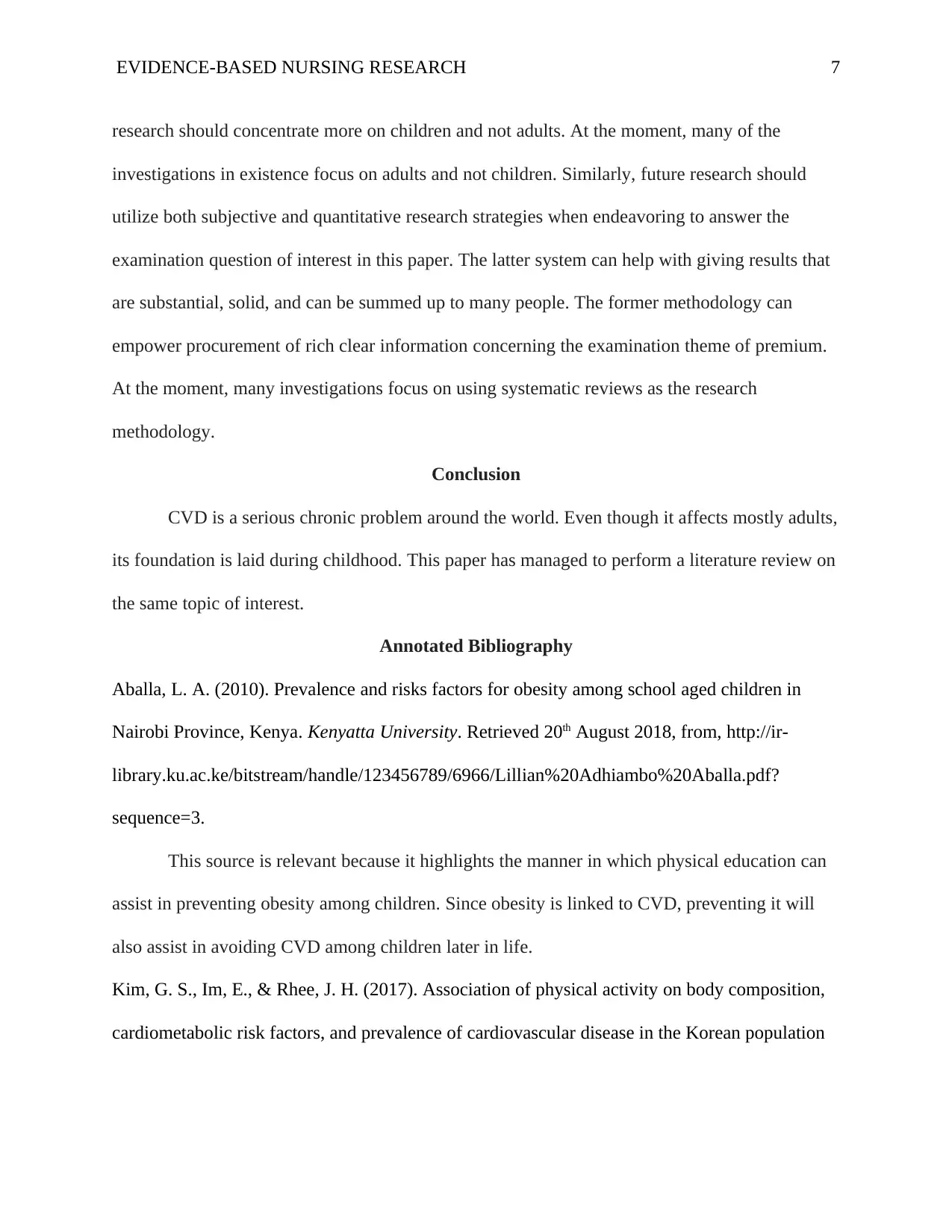
EVIDENCE-BASED NURSING RESEARCH 7
research should concentrate more on children and not adults. At the moment, many of the
investigations in existence focus on adults and not children. Similarly, future research should
utilize both subjective and quantitative research strategies when endeavoring to answer the
examination question of interest in this paper. The latter system can help with giving results that
are substantial, solid, and can be summed up to many people. The former methodology can
empower procurement of rich clear information concerning the examination theme of premium.
At the moment, many investigations focus on using systematic reviews as the research
methodology.
Conclusion
CVD is a serious chronic problem around the world. Even though it affects mostly adults,
its foundation is laid during childhood. This paper has managed to perform a literature review on
the same topic of interest.
Annotated Bibliography
Aballa, L. A. (2010). Prevalence and risks factors for obesity among school aged children in
Nairobi Province, Kenya. Kenyatta University. Retrieved 20th August 2018, from, http://ir-
library.ku.ac.ke/bitstream/handle/123456789/6966/Lillian%20Adhiambo%20Aballa.pdf?
sequence=3.
This source is relevant because it highlights the manner in which physical education can
assist in preventing obesity among children. Since obesity is linked to CVD, preventing it will
also assist in avoiding CVD among children later in life.
Kim, G. S., Im, E., & Rhee, J. H. (2017). Association of physical activity on body composition,
cardiometabolic risk factors, and prevalence of cardiovascular disease in the Korean population
research should concentrate more on children and not adults. At the moment, many of the
investigations in existence focus on adults and not children. Similarly, future research should
utilize both subjective and quantitative research strategies when endeavoring to answer the
examination question of interest in this paper. The latter system can help with giving results that
are substantial, solid, and can be summed up to many people. The former methodology can
empower procurement of rich clear information concerning the examination theme of premium.
At the moment, many investigations focus on using systematic reviews as the research
methodology.
Conclusion
CVD is a serious chronic problem around the world. Even though it affects mostly adults,
its foundation is laid during childhood. This paper has managed to perform a literature review on
the same topic of interest.
Annotated Bibliography
Aballa, L. A. (2010). Prevalence and risks factors for obesity among school aged children in
Nairobi Province, Kenya. Kenyatta University. Retrieved 20th August 2018, from, http://ir-
library.ku.ac.ke/bitstream/handle/123456789/6966/Lillian%20Adhiambo%20Aballa.pdf?
sequence=3.
This source is relevant because it highlights the manner in which physical education can
assist in preventing obesity among children. Since obesity is linked to CVD, preventing it will
also assist in avoiding CVD among children later in life.
Kim, G. S., Im, E., & Rhee, J. H. (2017). Association of physical activity on body composition,
cardiometabolic risk factors, and prevalence of cardiovascular disease in the Korean population
Paraphrase This Document
Need a fresh take? Get an instant paraphrase of this document with our AI Paraphraser
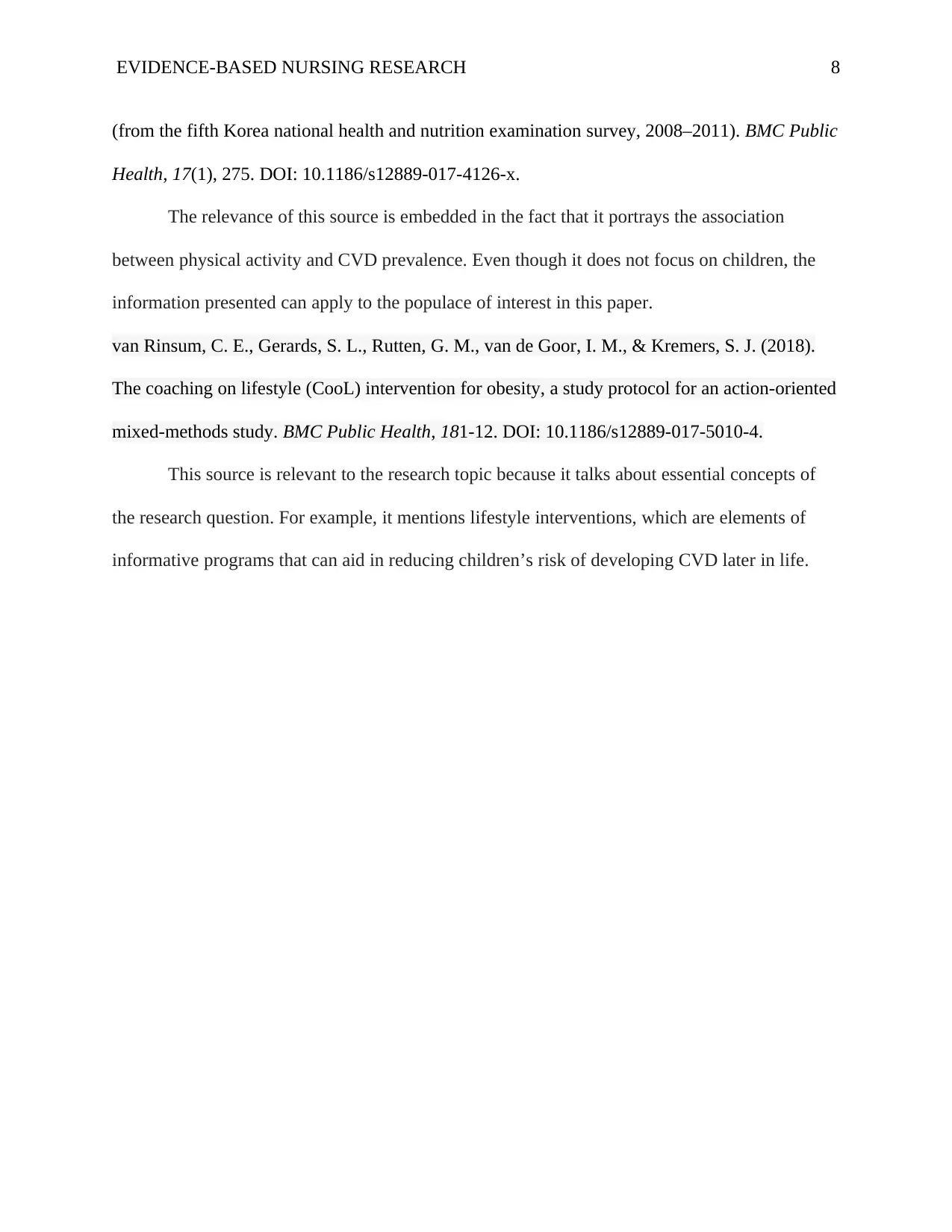
EVIDENCE-BASED NURSING RESEARCH 8
(from the fifth Korea national health and nutrition examination survey, 2008–2011). BMC Public
Health, 17(1), 275. DOI: 10.1186/s12889-017-4126-x.
The relevance of this source is embedded in the fact that it portrays the association
between physical activity and CVD prevalence. Even though it does not focus on children, the
information presented can apply to the populace of interest in this paper.
van Rinsum, C. E., Gerards, S. L., Rutten, G. M., van de Goor, I. M., & Kremers, S. J. (2018).
The coaching on lifestyle (CooL) intervention for obesity, a study protocol for an action-oriented
mixed-methods study. BMC Public Health, 181-12. DOI: 10.1186/s12889-017-5010-4.
This source is relevant to the research topic because it talks about essential concepts of
the research question. For example, it mentions lifestyle interventions, which are elements of
informative programs that can aid in reducing children’s risk of developing CVD later in life.
(from the fifth Korea national health and nutrition examination survey, 2008–2011). BMC Public
Health, 17(1), 275. DOI: 10.1186/s12889-017-4126-x.
The relevance of this source is embedded in the fact that it portrays the association
between physical activity and CVD prevalence. Even though it does not focus on children, the
information presented can apply to the populace of interest in this paper.
van Rinsum, C. E., Gerards, S. L., Rutten, G. M., van de Goor, I. M., & Kremers, S. J. (2018).
The coaching on lifestyle (CooL) intervention for obesity, a study protocol for an action-oriented
mixed-methods study. BMC Public Health, 181-12. DOI: 10.1186/s12889-017-5010-4.
This source is relevant to the research topic because it talks about essential concepts of
the research question. For example, it mentions lifestyle interventions, which are elements of
informative programs that can aid in reducing children’s risk of developing CVD later in life.
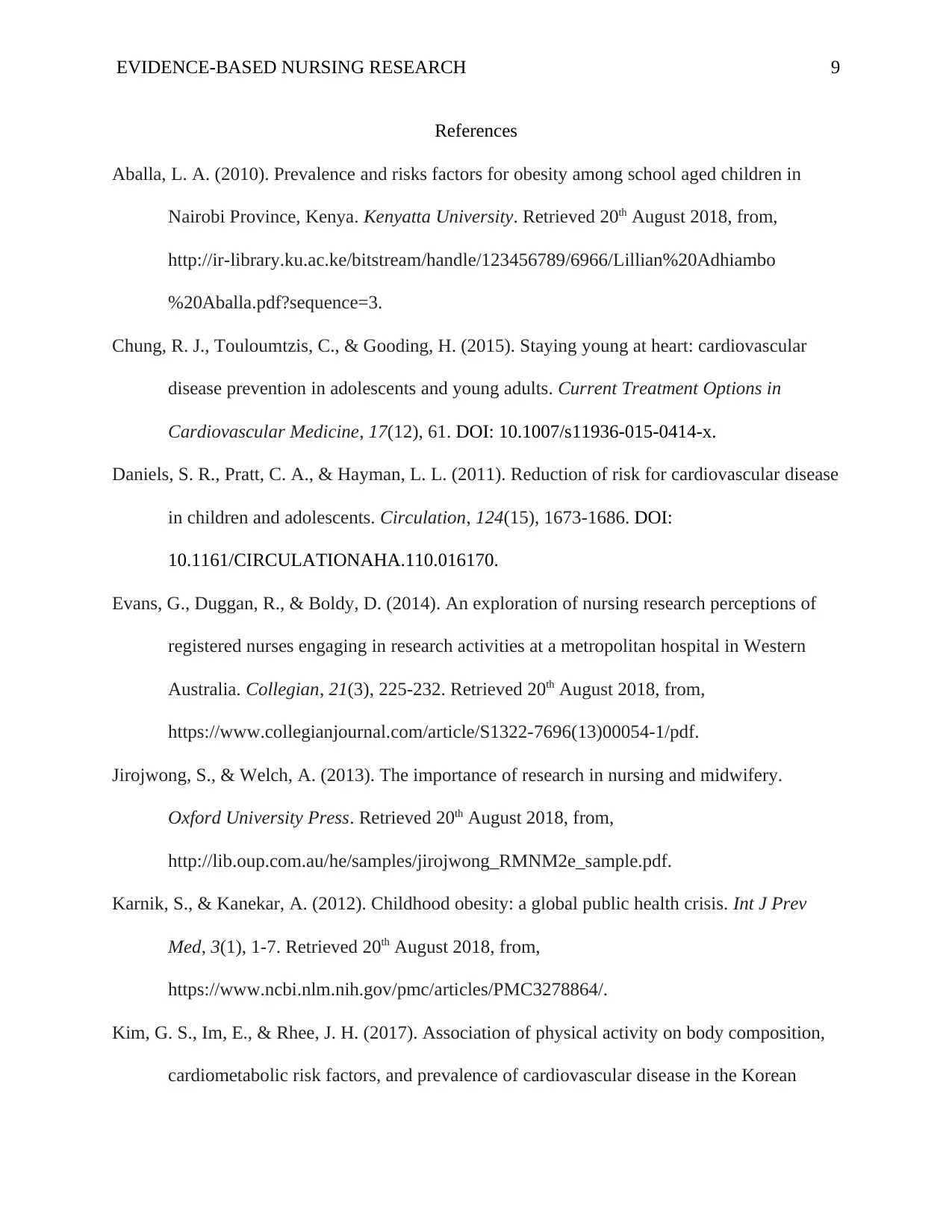
EVIDENCE-BASED NURSING RESEARCH 9
References
Aballa, L. A. (2010). Prevalence and risks factors for obesity among school aged children in
Nairobi Province, Kenya. Kenyatta University. Retrieved 20th August 2018, from,
http://ir-library.ku.ac.ke/bitstream/handle/123456789/6966/Lillian%20Adhiambo
%20Aballa.pdf?sequence=3.
Chung, R. J., Touloumtzis, C., & Gooding, H. (2015). Staying young at heart: cardiovascular
disease prevention in adolescents and young adults. Current Treatment Options in
Cardiovascular Medicine, 17(12), 61. DOI: 10.1007/s11936-015-0414-x.
Daniels, S. R., Pratt, C. A., & Hayman, L. L. (2011). Reduction of risk for cardiovascular disease
in children and adolescents. Circulation, 124(15), 1673-1686. DOI:
10.1161/CIRCULATIONAHA.110.016170.
Evans, G., Duggan, R., & Boldy, D. (2014). An exploration of nursing research perceptions of
registered nurses engaging in research activities at a metropolitan hospital in Western
Australia. Collegian, 21(3), 225-232. Retrieved 20th August 2018, from,
https://www.collegianjournal.com/article/S1322-7696(13)00054-1/pdf.
Jirojwong, S., & Welch, A. (2013). The importance of research in nursing and midwifery.
Oxford University Press. Retrieved 20th August 2018, from,
http://lib.oup.com.au/he/samples/jirojwong_RMNM2e_sample.pdf.
Karnik, S., & Kanekar, A. (2012). Childhood obesity: a global public health crisis. Int J Prev
Med, 3(1), 1-7. Retrieved 20th August 2018, from,
https://www.ncbi.nlm.nih.gov/pmc/articles/PMC3278864/.
Kim, G. S., Im, E., & Rhee, J. H. (2017). Association of physical activity on body composition,
cardiometabolic risk factors, and prevalence of cardiovascular disease in the Korean
References
Aballa, L. A. (2010). Prevalence and risks factors for obesity among school aged children in
Nairobi Province, Kenya. Kenyatta University. Retrieved 20th August 2018, from,
http://ir-library.ku.ac.ke/bitstream/handle/123456789/6966/Lillian%20Adhiambo
%20Aballa.pdf?sequence=3.
Chung, R. J., Touloumtzis, C., & Gooding, H. (2015). Staying young at heart: cardiovascular
disease prevention in adolescents and young adults. Current Treatment Options in
Cardiovascular Medicine, 17(12), 61. DOI: 10.1007/s11936-015-0414-x.
Daniels, S. R., Pratt, C. A., & Hayman, L. L. (2011). Reduction of risk for cardiovascular disease
in children and adolescents. Circulation, 124(15), 1673-1686. DOI:
10.1161/CIRCULATIONAHA.110.016170.
Evans, G., Duggan, R., & Boldy, D. (2014). An exploration of nursing research perceptions of
registered nurses engaging in research activities at a metropolitan hospital in Western
Australia. Collegian, 21(3), 225-232. Retrieved 20th August 2018, from,
https://www.collegianjournal.com/article/S1322-7696(13)00054-1/pdf.
Jirojwong, S., & Welch, A. (2013). The importance of research in nursing and midwifery.
Oxford University Press. Retrieved 20th August 2018, from,
http://lib.oup.com.au/he/samples/jirojwong_RMNM2e_sample.pdf.
Karnik, S., & Kanekar, A. (2012). Childhood obesity: a global public health crisis. Int J Prev
Med, 3(1), 1-7. Retrieved 20th August 2018, from,
https://www.ncbi.nlm.nih.gov/pmc/articles/PMC3278864/.
Kim, G. S., Im, E., & Rhee, J. H. (2017). Association of physical activity on body composition,
cardiometabolic risk factors, and prevalence of cardiovascular disease in the Korean
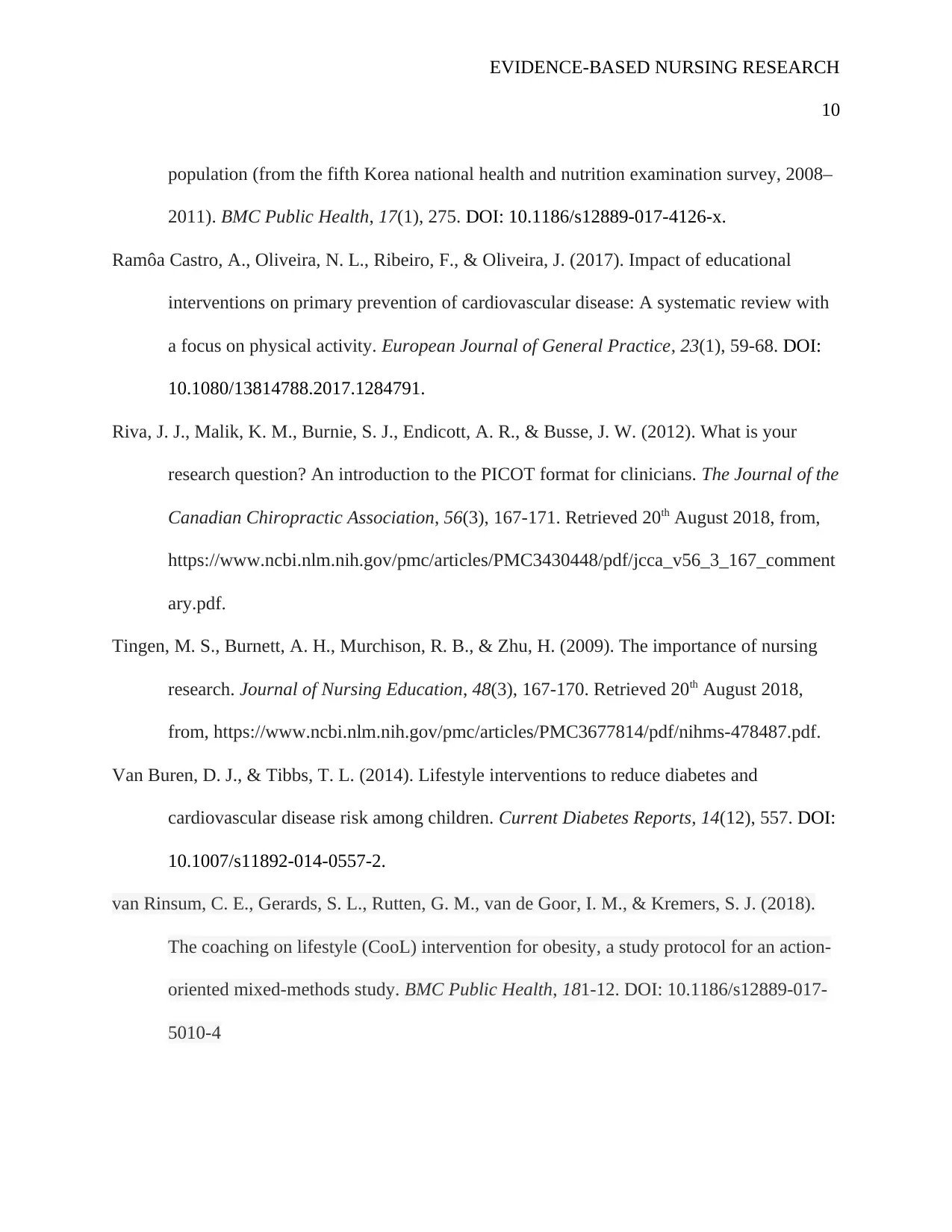
EVIDENCE-BASED NURSING RESEARCH
10
population (from the fifth Korea national health and nutrition examination survey, 2008–
2011). BMC Public Health, 17(1), 275. DOI: 10.1186/s12889-017-4126-x.
Ramôa Castro, A., Oliveira, N. L., Ribeiro, F., & Oliveira, J. (2017). Impact of educational
interventions on primary prevention of cardiovascular disease: A systematic review with
a focus on physical activity. European Journal of General Practice, 23(1), 59-68. DOI:
10.1080/13814788.2017.1284791.
Riva, J. J., Malik, K. M., Burnie, S. J., Endicott, A. R., & Busse, J. W. (2012). What is your
research question? An introduction to the PICOT format for clinicians. The Journal of the
Canadian Chiropractic Association, 56(3), 167-171. Retrieved 20th August 2018, from,
https://www.ncbi.nlm.nih.gov/pmc/articles/PMC3430448/pdf/jcca_v56_3_167_comment
ary.pdf.
Tingen, M. S., Burnett, A. H., Murchison, R. B., & Zhu, H. (2009). The importance of nursing
research. Journal of Nursing Education, 48(3), 167-170. Retrieved 20th August 2018,
from, https://www.ncbi.nlm.nih.gov/pmc/articles/PMC3677814/pdf/nihms-478487.pdf.
Van Buren, D. J., & Tibbs, T. L. (2014). Lifestyle interventions to reduce diabetes and
cardiovascular disease risk among children. Current Diabetes Reports, 14(12), 557. DOI:
10.1007/s11892-014-0557-2.
van Rinsum, C. E., Gerards, S. L., Rutten, G. M., van de Goor, I. M., & Kremers, S. J. (2018).
The coaching on lifestyle (CooL) intervention for obesity, a study protocol for an action-
oriented mixed-methods study. BMC Public Health, 181-12. DOI: 10.1186/s12889-017-
5010-4
10
population (from the fifth Korea national health and nutrition examination survey, 2008–
2011). BMC Public Health, 17(1), 275. DOI: 10.1186/s12889-017-4126-x.
Ramôa Castro, A., Oliveira, N. L., Ribeiro, F., & Oliveira, J. (2017). Impact of educational
interventions on primary prevention of cardiovascular disease: A systematic review with
a focus on physical activity. European Journal of General Practice, 23(1), 59-68. DOI:
10.1080/13814788.2017.1284791.
Riva, J. J., Malik, K. M., Burnie, S. J., Endicott, A. R., & Busse, J. W. (2012). What is your
research question? An introduction to the PICOT format for clinicians. The Journal of the
Canadian Chiropractic Association, 56(3), 167-171. Retrieved 20th August 2018, from,
https://www.ncbi.nlm.nih.gov/pmc/articles/PMC3430448/pdf/jcca_v56_3_167_comment
ary.pdf.
Tingen, M. S., Burnett, A. H., Murchison, R. B., & Zhu, H. (2009). The importance of nursing
research. Journal of Nursing Education, 48(3), 167-170. Retrieved 20th August 2018,
from, https://www.ncbi.nlm.nih.gov/pmc/articles/PMC3677814/pdf/nihms-478487.pdf.
Van Buren, D. J., & Tibbs, T. L. (2014). Lifestyle interventions to reduce diabetes and
cardiovascular disease risk among children. Current Diabetes Reports, 14(12), 557. DOI:
10.1007/s11892-014-0557-2.
van Rinsum, C. E., Gerards, S. L., Rutten, G. M., van de Goor, I. M., & Kremers, S. J. (2018).
The coaching on lifestyle (CooL) intervention for obesity, a study protocol for an action-
oriented mixed-methods study. BMC Public Health, 181-12. DOI: 10.1186/s12889-017-
5010-4
1 out of 10
Related Documents
Your All-in-One AI-Powered Toolkit for Academic Success.
+13062052269
info@desklib.com
Available 24*7 on WhatsApp / Email
![[object Object]](/_next/static/media/star-bottom.7253800d.svg)
Unlock your academic potential
© 2024 | Zucol Services PVT LTD | All rights reserved.





